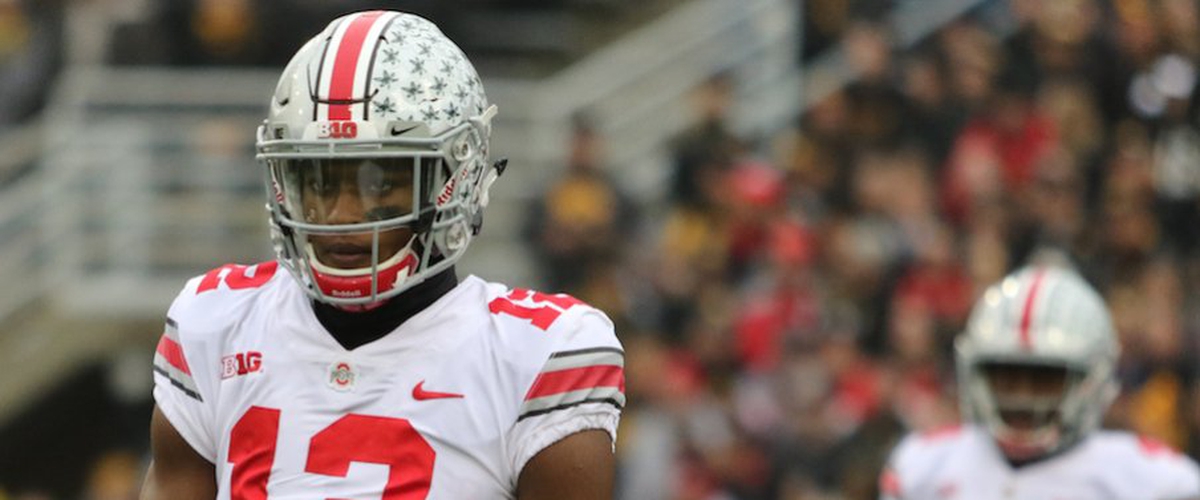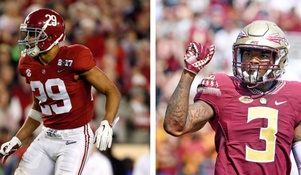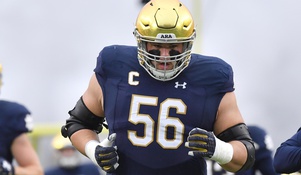2018 NFL Draft by Position: Cornerbacks (10/11)

For the second straight year, Ohio State produces the best Cornerback prospect. Denzel Ward was originally slotted as a mid-1st round pick, but his stock has risen as high as a potential pick for Denver at #5. Other talented corners will follow Ward on Day One, most certainly Josh Jackson and Jaire Alexander. Prospects like Mike Hughes and Isaiah Oliver might sneak their way in late on Thursday, especially if a team is looking for a lengthy, athletic corner. This is a deep Cornerback class that could see as many as eight corners going in just the first two rounds, so it's smart to become familiar with most, if not all, of these future rookies. Let's get started with the Buckeye...
1. Denzel Ward, Ohio State - Top 10 Pick
Denzel Ward is going to be a really good NFL Cornerback right away. He has the experience and overall skill set to play outside fairly well, but his good footwork and not-so-good play strength, especially against big receivers, should solidify his case as an elite Slot Cornerback. Ward's instincts on route-reading are superb, and he's by far the best one-on-one Cornerback in this class. His technique and motor help him guard receivers anywhere on the field. Ward's an instant starter at Nickel Cornerback, with the ability to split CB2 duties right away. Teams that face a pass-first powerhouse in their division twice a season would kill to have Ward on their depth chart. While he may not develop into a Pro Bowler, he should develop quickly into a poor man's Chris Harris.
2. Josh Jackson, Iowa - Mid/Late 1st Round
Josh Jackson may only be six feet tall, but his super-long arms help him maximize his length. He exploded onto the scene his Junior year, and while some may criticize that he's only had one good year, picking off Ohio State three times in one game and adding an Interception in Iowa's bowl game defends the fact he plays up to the level of his opponents consistently. The talent is there for Jackson, but his inexperience and inconsistencies following routes may haunt him at the next level. His instincts and mentality are definitely there, and while Jackson may only be a mediocre CB2 option right away, he has the tools to be a lesser-Josh Norman, shutdown corner in the future.
3. Jaire Alexander, Louisville - Mid 1st/Early 2nd Round
Jaire Alexander was ranked as a mid-to-late 2nd rounder before he ran a 4.38 forty at the combine. He doesn't have great height (5'10"), and his slender build combined with a sprained knee he battled through most of 2017 raises durability concerns at the next level. Alexander's speed helps him deserve Nickel Cornerback starting reps, and if he can stay healthy, he has a realistic upside of a Teez Tabor-like CB2.
4. Mike Hughes, Central Florida - Late 1st/Early 2nd Round
Mike Hughes is a tough pressure corner, but his tape shows inexperience and inconsistency. He's a bit short (5'10"), but his skill set is best suited to stay outside. Teams will look at Hughes for what he can be, and not what he'll provide come September. He's a talented returner who could make an instant impact in a variety of special teams roles, but he simply needs to grow and develop more experience in different coverage packages before he can see his potential as a Bradley Roby-like CB2.
5. Isaiah Oliver, Colorado - Late 1st/Mid 2nd Round
Isaiah Oliver's size and length (6', 200 lb. and freakishly-long arms) combined with his in-game speed make his measurables drool-worthy. He needs to develop a mean streak, and his tape shows inconsistency in coverage. Oliver has a ceiling of a better-Artie Burns, bump-and-run CB1, but it will probably take him longer to develop than the Cornerbacks ranked above him. Limiting Oliver's role may be best for his development in year one.
6. Donte Jackson, LSU - Late 1st/2nd Round
One number can represent Donte Jackson's draft stock: 4.32. That was his 40-yard-dash time, tied for the best out of all 335 athletes at the combine. Jackson's a cover-first corner, but he doesn't have the ideal body (5'11", 178 lb.) for that role in the NFL. His instincts are poor, but he can close down receivers better than anyone in this draft class. The athletic ability should guarantee Jackson some playing time, but he has a lot of work to do regarding reading routes and focusing in general. Jackson should be an instant CB3 with an immediate special teams impact and a far-down-the-road potential of a Leodis McKelvin-like CB2.
7. Carlton Davis, Auburn - 2nd Round
Carlton Davis measured 6'1" and 206 pounds at the combine, and his long arms and 4.53 40-yard-dash round out his eerily similar profile of Richard Sherman. His ball skills are great, but his tape also shows Davis struggles with matching receivers. He's best in a press corner role, although his confidence, mean streak and overall competitiveness may help Davis develop into an all-around shutdown corner. Davis may only be a CB3 with press-only responsibilities in certain packages right away, but if he's developed in the right scheme, he has a Legion of Boom-like CB1 ceiling.
8. M.J. Stewart, North Carolina - Mid 2nd/Mid 3rd Round
M.J. Stewart is built well enough (5'11", 200 lb.) to have his dual-threat presence in both coverage and run support translate over to the next level. His athleticism is good enough for man coverage in the NFL, and his skill set gives him the flexibility of playing both inside and outside. Safety-need teams may also see Stewart's instincts, IQ and toughness as a good candidate for a position change. Stewart's ceiling isn't as high as other corners, but his versatility should see him get reps in an abundance of packages, with a high-end CB3 potential like Micah Hyde.
9. Duke Dawson, Florida - 3rd/4th Round
At 5'11" and a well-distributed 197 pounds, Duke Dawson is a sturdy, strong Slot Cornerback. He's great at throwing of receivers' initial release, and his tape is filled with receivers forcibly abandoning their routes because of Dawson. His hips are too tight, and Dawson's tape also shows his consistent struggles when backpedaling. His lack of length and speed should keep him to a man coverage and run support role, but that fits Dawson's skill set best anyways. He may be only a CB4 year one, but bettering his instincts should help him develop quickly into a starting Nickel Cornerback.
10. Anthony Averett, Alabama - 3rd/4th Round
Anthony Averett is an absolute athlete, posting a 4.36 forty and one of the best broad jumps in the nation. With loose hips and quick feet, he'll instantly be solid in man coverage at the next level. Averett's frame (5'11", 183 lb.) isn't great, and his awful production, represented by just one career Interception at Alabama, is a major concern. His route recognition is pretty good, but Averett's tape shows he plays the receiver far more than playing the ball, a bad habit that may take time to break. He may have to start as a depth option with significant special teams reps, but Averett does bear a realistic upside of a Tre'Davious White (minus his production) mold CB2/CB3.
11. Isaac Yiadom, Boston College - 3rd/5th Round
Isaac Yiadom is tall (6'1") with long arms, and despite his thin 190-pound frame, his decent play strength and exceptional aggressiveness helps him play bigger than he actually is. His instincts and awareness are okay, and he held his own in zone coverage. Yiadom can add a tremendous special teams value that may be enough to bump him into a Day 2 conversation. His technique and production in man coverage still needs plenty of work, and while he's only a depth option year one, Yiadom has a likely upside of a quality CB2 in a few years. I see a lot of Bashaud Breeland in Yiadom.
12. Tarvarus McFadden, Florida State - 3rd/5th Round
Tarvarus McFadden may be the biggest wild card out of all corner prospects. His big frame (6'2", 204 lb.) automatically helps him as a talented press corner, and his tape shows McFadden and his long arms as a major disruptor against good ACC competition. His highlight-reel Interceptions pass the eye test, but scouts have studied his tape and noticed his overall ball skills and production dropped off significantly in 2017. Early mock drafts had McFadden landing as high as the early 2nd round, but his poor 4.67 forty at the combine slashed his stock significantly. While his cover technique is consistent, his lack of speed may bump him into a zone coverage specialist in the NFL. McFadden's tackling issues may be enough to push his stock back to Day 3, and if he can't find the ball skills he showcased in 2016, it may be a long time before McFadden sees anything more than zone-specific and special teams reps.
13. Holton Hill, Texas - Late 3rd/5th Round
Holton Hill has scouts enamored with his size (6'2", 196 lb.) and overall athletic ability. His tape shows inconsistent footwork and a bad habit of pass interference. Hill's instincts and strength in run support are fantastic for a first-year player, good enough for teams to potentially move him to Safety if they deem necessary. His 4.49 forty was a bit slower than scouts hoped, likely bumping him to Day 3, and he has a lot of maturity issues that could be enough to scare teams off from taking him. Hill grew tremendously as a coverage corner throughout 2017, and if he gets his act together, he can develop from a backup option into a potential CB3 or third safety.
14. Parry Nickerson, Tulane - Late 3rd/5th Round
Parry Nickerson, like Donte Jackson, ran a lightning-fast 4.32 forty, tied for the best out of all prospects. His poor size (5'10", 186 lb.) and equally poor play strength should constrict him to a slot-only role. Luckily, his skill set translates well as a slot corner at the next level. Nickerson has elite instincts, intelligence and he plays tough. His consistently poor tackling at Tulane raises concerns, but with good coaching, Nickerson should develop into a starting Nickel Cornerback relatively soon. That's about as high as his ceiling gets, though.
15. Quenton Meeks, Stanford - 4th/5th Round
Quenton Meeks has the technique to be a solid outside Cornerback at the next level, and his size (6'1", 209 lb.) translate just as well. However, he'll need scheme-specific help, and most of the good parts of his Stanford tape showed he got help from talented Safety peer Justin Reid. Meeks' poor speed and acceleration, both testing and in-game, make him a liability in coverage right away. He's not great in one-on-one coverage, and receivers with good initial bursts blow by him far too often. Meeks can tackle, and his high IQ and instincts may make him a better Safety at the next level. Overall, he's a depth option all over the secondary right away, but with a limited ceiling of a versatile backup option at best.
16. Avonte Maddox, Pittsburgh - 4th/6th Round
First and foremost, Avonte Maddox is a strong leader and a hard worker. His toughness and athleticism are NFL-ready, but his small frame (5'9", 184 lb.) and inconsistency in coverage worry scouts. Maddox has great acceleration (4.39 forty) and in-game speed, and his impact on special teams will be felt immediately. Still, Maddox needs to give far less space to receivers and find some way to make up for his lack of height if he wants to develop into anything more than a depth option.
17. Nick Nelson, Wisconsin - Late 4th/6th Round
Nick Nelson's 5'11", 200-pound frame is strong, but he doesn't offer the length or height front offices are looking for in Cornerback prospects. His ball skills are so hard to determine, as he had over 40 deflections in his Wisconsin career but zero Interceptions. Nelson is one of the worst pass interference offenders in this entire draft class, a hard habit to break. His athleticism is decent, and he's versatile enough to be used in any coverage package. His meniscus surgery went well, and it now looks like he'll be back by training camp, so teams looking to draft a cover-first corner with a health-based CB2 upside will have to take him earlier on Day 3 than later.
18. Tony Brown, Alabama - 5th/6th Round
Tony Brown is built strong (6', 200 lb.), and he proved his strength with exceptional run support on his Alabama tape. His extremely tight hips made it hard for him to match one-on-one with receivers, and his ball skills are far below where they should be. There's a chance some teams see Brown as a hybrid Linebacker, and his 4.35 forty proves how much of a special teams impact he will have. Brown's initial reps will likely be package-based, but with improved footwork and instincts, he does have the upside of a decent Johnson Bademosi-like Nickel Cornerback and special teams superstar.
19. D.J. Reed, Kansas State - 5th/7th Round
D.J. Reed has the size (5'9", 188 lb.) to only play as a slot corner, but that's ideal for his solid athleticism and impressive tackling ability. He's a mentally-strong workhorse who never gives up on plays, even when paired against much larger one-on-one receivers. Reed's exceptional returning ability should help his stock, although it's unlikely he develops into anything much more than a sub-package-only corner.
20. J.C. Jackson, Maryland - 5th/7th Round
At 5'10" and 201 pounds, J.C. Jackson has a sturdy build that he used to consistently disrupt receivers' routes. He's only spent two seasons at a full-time corner, so his instincts and awareness are still very raw. Jackson's speed and acceleration are both mediocre, but he held his own in both bump-and-run and zone coverage at Maryland. His ball skills need a ton of work, and while he's underdeveloped enough to start the season on a practice squad, he still has a CB2 upside far down the road.
21. Kevin Toliver, LSU - 5th/7th Round
Kevin Toliver has impressive size (6'2", 192 lb.), but never figured out how to use it productively at LSU. His physically finally caught up with his body in 2017, and his tape shows a slow-but-still-upward trend in development over the past three seasons. Toliver's ball skills are awful, but he could handle zone-happy package reps right away. Character issues hurt his stock further, and teams will have to try and figure out a way to manipulate his impressive size - it's the only thing keeping Toliver on any roster.
22. Davontae Harris, Illinois State - 5th Round/Undrafted
Davontae Harris measures in at 5'11" and 205 pounds, a good build to match his versatility at both Corner and Safety. His speed (4.43 forty) is good, but his instincts and direction-changing get him in trouble far too often. Harris struggles to shut down receivers in one-on-one match-ups, but his toughness and impressive run support should help Harris develop into a decent back-up at both corner and Safety. He may have to start on the practice squad, though.
23. Taron Johnson, Weber State - 5th Round/Undrafted
Taron Johnson's average size (5'11", 192 lb.), quick feet and decent coverage instincts have him pegged immediately into a Nickel corner role at the next level. His mediocre 4.5 forty bumped his draft stock down from early Day 3 to late, if drafted at all. Johnson's initial quickness is NFL ready, but he'll have to fight in camp for his role as a CB4 and back-up Nickel Corner. That's probably about what Johnson's ceiling sits at too.
24. Brandon Facyson, Virginia Tech - 6th Round/Undrafted
Brandon Facyson has great size (6'2", 203 lb.) and long arms, both of which he used to throw off talented ACC receivers on a consistent basis. However, his tape is filled with instances of Facyson tripping over himself while keeping up with complex routes. Facyson also gets beat by most top-end speed receivers, causing instant match-up troubles at the next level. His only real shot at immediate playing time is teams looking to rotate corners in Cover 2 or press-happy packages. If Facyson can find a way to keep up with NFL-speed receivers, he has a shot down the road to develop into a press-first CB3. That's a big "if", though.
25. Chris Campbell, CB, Penn State - 6th Round/Undrafted
Chris Campbell is lean but long (6'1, 195 lb., long arms). Right now, that's his best attribute. Campbell doesn't play fluidly, lacks quickness and relied on his length far too much to cover up his awful footwork. He's also only started four games over his three year career at Penn State. Campbell never showed any ball skills in college, but if he can find some in his private workouts (or fix any of his other bad traits), it may be enough to keep him on a roster. Campbell will be a fringe roster player for the near future.
26. Levi Wallace, Alabama - 6th Round/Undrafted
Levi Wallace has a poor frame (6', 179 lb.) and lacks next-level speed (4.63 forty), two negatives that might just be enough to prevent him from being drafted. However, he's worked his way from walking on at Alabama to starting confidently his senior season. Wallace's athleticism and ball skills are better than many other Day 3 corners, but his lack of play strength is a major concern. If he doesn't get faster or stronger come September, there's a good chance he'll be looking for a practice squad to play on.
27. Rashaan Gaulden, Tennessee - 6th Round/Undrafted
It's hard to see what kind of NFL player Rashaan Gaulden will be. His 6'1" 197 pound frame is decent, but he lacks next-level speed (4.61 forty) and strength (only 8 bench reps). Gaulden's maturity concerns are accurately represented by him flipping off the Alabama fans after a blowout loss. His aggression, physicality and toughness suggest he may be a better Safety prospect, but he intentionally worked out with the Cornerbacks at the combine. Gaulden has a realistic upside of a decent backup Nickel Cornerback and Safety, if he doesn't get himself cut in training camp by being an idiot.
28. Darius Phillips, Western Michigan - 6th Round/Undrafted
Darius Phillips simply finds a way to get to the ball. His athleticism and redirect quickness make him qualified for man coverage out of the slot right away in the NFL. However, Phillips is downright terrible at tackling, meaning if he plays inside, opposing offensive coordinators can exploit that disadvantage every time he's on the field. His 4.54 forty at the combine may have helped him enough to get drafted, but the team he ends up on must value ball skills over toughness. Phillips doesn't have much potential, with his upside resting as a decent backup slot corner.
29. Tremon Smith, Central Arkansas - 7th Round/Undrafted
Tremons Smith's tape shows a confident, ready-to-fight island corner, a rarity coming out of college. However, he was also facing FCS receivers. Smith's size (6', 190 lb.) doesn't scream island corner, but his in-game speed, athleticism and quality instincts are NFL-ready. Teams could play Smith outside or in the slot, but he commits a terribly-high amount of stupid penalties. It's unlikely there will be any other Cornerbacks better than him that can play outside of the slot when the 7th Round comes along, and that's his best shot at getting drafted. He'll never be much more than just a bench option, though.
30. Grant Haley, Penn State - 7th Round/Undrafted
Grant Haley is a slot corner with an NFL slot corner build (5'9", 190 lb.). His athleticism and foot quickness are decent enough for the position, and his 4.44 forty boosts his draft stock. Haley is a poor tackler, a major concern playing the slot, and while he could eventually be an okay backup Slot Cornerback, he may not get a chance on an active roster if he doesn't learn how to tackle at the next level. Haley's four years of special teams experiences helps his odds, though.
Other Cornerbacks with training camp chances: Greg Stroman, Virginia Teh; Jamarcus King, South Carolina; Michael Joseph, Dubuque; Mike Ford, Southeast Missouri State; Danny Johnson, Southern; D'montre Wade, Murray State; Rashard Fant, Indiana; Deatrick Nichols, South Florida; Chandon Sullivan, Georgia State



